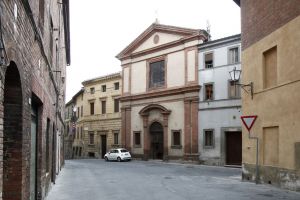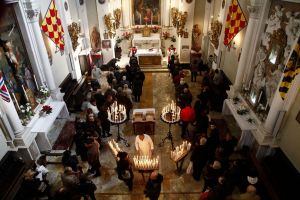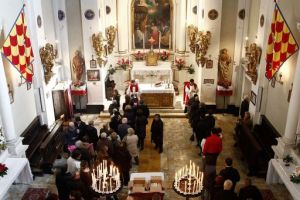Church of San Niccolò al Carmine
The Confraternity and the Feast of St Lucy
Towards the end of the thirteenth century, the Confraternity of SS. Nicholas and Lucy, a brotherhood of laymen, was established at the church to accomplish charitable and pious acts for those in need. In 1398 the Confraternity moved into the rooms annexed to the nearby church of Saint Lucy, which were used as a hospital.
Anyone who happens to be in Siena on December 13th can take part in the Feast of Saint Lucy, a two-century long tradition to which all the people of Siena, regardless of their Contrada, are particular fond of.
It is a popular religious festival during which every devotee entering the church takes two round rolls, which symbolise saint’s eyes, and a candle, the sign of spiritual enlightenment and reminiscent of the Saint’s name, which means light. The candle is lit and placed on special candlesticks and, before leaving the church, it is possible to have ones eyes blessed.
The road outside the church is lined by stalls selling the typical ceramic bells painted in the colours of the different Contrade, most likely in memory of the fact that once many pitcher makers and ceramists, the artisans that used to produce earthenware items, had their workshops in this area.
Anyone who happens to be in Siena on December 13th can take part in the Feast of Saint Lucy, a two-century long tradition to which all the people of Siena, regardless of their Contrada, are particular fond of.
It is a popular religious festival during which every devotee entering the church takes two round rolls, which symbolise saint’s eyes, and a candle, the sign of spiritual enlightenment and reminiscent of the Saint’s name, which means light. The candle is lit and placed on special candlesticks and, before leaving the church, it is possible to have ones eyes blessed.
The road outside the church is lined by stalls selling the typical ceramic bells painted in the colours of the different Contrade, most likely in memory of the fact that once many pitcher makers and ceramists, the artisans that used to produce earthenware items, had their workshops in this area.





